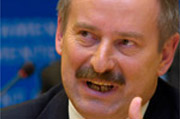Hearing of the TRAN committee on the TEN-T guidelines
08/05/2012

Speech delivered by Vice-President Siim Kallas at the hearing of the TRAN committee on the TEN-T guidelines
Chair, Dear Brian,
Honourable Members,
I would like to thank the rapporteurs, Mr Ertug and Mr Koumoutsakos, and the TRAN committee for organising this hearing on the Commission's important proposal to revise the TEN-T guidelines.
The trans-European transport networks are not new: they have been part of EU policy for more than 15 years. Today, there can be no doubt that a European transport network is the essential backbone for completing the internal market.
But we have still not fully achieved this single network, which is crucial for enabling the free movement of people and goods. Some projects have made good progress - others less so. Most importantly, cross-border sections are still missing. Trains face unnecessary delays when crossing borders because of a lack of interoperability. And the different modes of transport are not well linked together.
We also face several new challenges, as last year's White Paper on Transport explains. Transport demand will continue to increase. At the same time, we need to reduce greenhouse gas emissions from transport as well as our dependence on oil.
We will not be able to tackle these challenges if Europe does not have the necessary infrastructure in place. We need this to provide long-distance transport with alternatives to roads; to enable efficient transport that combines the different modes; to make available alternative clean fuels that can serve as innovative transport solutions.
The Commission's proposal takes the objectives of the Europe 2020 strategy fully into account. It changes key elements of the existing TEN-T policy:
- Instead of simply adding an increasingly large list of "priority projects" to national networks, we propose a real European infrastructure plan. This is based on an objective methodology that defines a comprehensive network and a core network. It will allow the Union to focus its efforts much more on those parts of the network with the highest EU added value. This is a central element of the proposal.
- We propose deadlines for completing the trans-European network: 2030 for the core network, 2050 for the comprehensive network. It is only by firmly engaging with a common target that all parties concerned can achieve the full "network effect" – and so maximise the benefits of their investments. These deadlines give an assurance to those investing in their infrastructure that the same will happen on the other parts of the network. This will significantly increase the benefits from investments.
- We set basic requirements to ensure that the infrastructure is fully interoperable and of the necessary quality. These requirements are particularly important for rail and inland waterways. In addition to interoperability, we want infrastructure that is safe, accessible for all users and also respects the environment. We also make sure that we make the best use of innovation to achieve the Union's ambitious environmental targets. Under the deadlines, we will ensure that - from an infrastructure point of view - a freight train which is 750m long, loaded with 22.5t per axle and equipped with ERTMS can run freely on the entire core network by 2030.
- We propose multimodal corridors to help implement the TEN-T. These will help synchronise investments and implementation across Member States. They will make cooperation very pragmatic and concrete between Member States, regional and local authorities, infrastructure managers and users. The European coordinators will oversee and facilitate the building of these corridors and assist whenever and wherever there are problems during the planning and construction phases.
- Last but not least, we have created a new infrastructure fund, the Connecting Europe Facility, to support efforts made by Member States and all parties concerned towards completion of the TEN-T. You have already held a hearing on the CEF and, as members of the TRAN committee, you will know that the amounts proposed are a necessary minimum.
I am satisfied with the compromise reached in Council because the Council respected the structure of the initial proposal and the methodology for the maps.
Changes introduced by the Council to the TEN-T maps are in line with the European approach taken by the Commission. There were only a few and mostly technical in nature.
It is now up to the European Parliament to make sure that the key points I have just listed remain the strong commitments of the TEN-T guidelines.
- Deadlines have to remain binding without safeguard clauses and loopholes;
- Standards and requirements need to remain strict to ensure interoperability, including on ERTMS, and for inland navigation, and they need to be consistent with environment-, climate change- and accessibility objectives;
- Finally, we need to preserve a strong governance structure to adequately involve all relevant actors such as regional and local authorities, infrastructure managers, users and others.
To sum up, the Commission has presented an ambitious but realistic set of proposals. Investing in efficient transport infrastructure is the basis for creating growth and jobs, especially at times of crisis.
With the TEN-T guidelines and the Connecting Europe Facility, we have a very solid basis to contribute to Europe's mobility and competitiveness. I hope that the TRAN committee and the Parliament will support the Commission proposals in this direction.
I thank you for your attention and wish you an interesting hearing.
Contacts :
Helen Kearns (+32 2 298 76 38)
Dale Kidd (+32 2 295 74 61)


